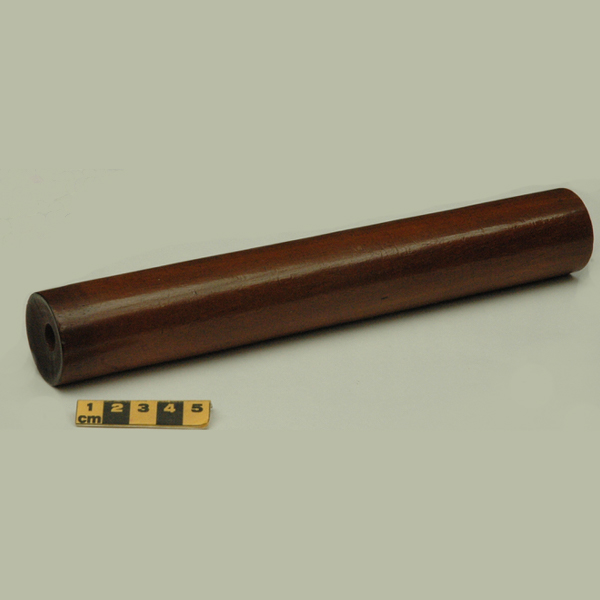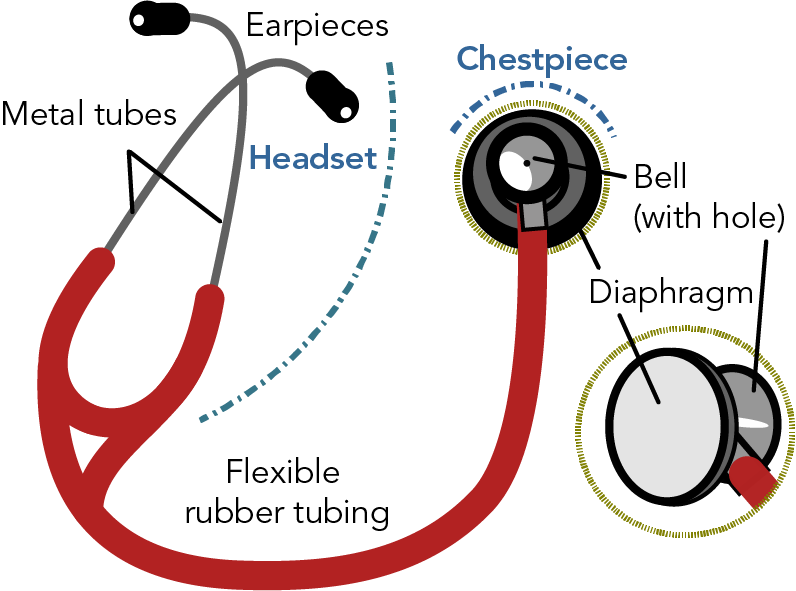Stethoscope Replica

Replica of the earliest wooden model stethoscope (Ingenium)

Replica of the earliest wooden model stethoscope (Ingenium)
How does this align with my curriculum?
Using stethoscopes, doctors can use sound waves to detect various health issues. Learn how this device has evolved since it was invented in 1816!
This stethoscope replica is a copy of the earliest wooden stethoscope. It was produced in 1929 for the History of Medicine Museum in Toronto. To learn more about this and other artifacts at the Canadian Science and Technology Museum, visit Ingenium.
Who invented the stethoscope?
The first monaural, or single-ear, stethoscope was invented in 1816 by a French doctor named Rene Laennec. At that time, doctors typically pressed their ear to a patient’s torso to examine their heart, lungs and bowels. But as you can imagine, this could be very awkward for some patients! Some doctors and patients even found the practice unhygienic. Not only that, but the method did not always work.
One day, Laennec had to examine a young woman with chest pains. This exam gave him the idea of using acoustics (sound transmission) to examine patients. He rolled up a piece of paper, pressed one end to her chest and pressed the other end to his ear. It worked! He could hear her heart. He was so impressed with his impromptu device that he built a portable wooden version. Quickly, this device became the standard tool for chest examinations.
Short TED Ed video which tells the story of the first stethoscope as well as shows you how to make a paper model of one (1:48 min.).
Doctors used monaural stethoscopes from about 1820–1850. Then, an Irish doctor named Arthur Leared introduced the binaural, or dual-ear, stethoscope. In the 1960s, an American doctor named David Litmann redesigned the stethoscope. He improved its acoustic performance. Later, he introduced the version that doctors most commonly use today. The stethoscope may seem like a simple tool. But thanks to this tool, doctors have helped millions of patients!
How does a stethoscope work?
Laennec’s original stethoscope was wooden and tube-shaped. But stethoscopes today look very different from his version! Modern stethoscopes have several major components. They have a chestpiece comprised of a diaphragm and a bell. Rubber tubing connects the chestpiece to a headset. The headset is comprised of metal tubing and earpieces.
You may already know that sound is caused by vibrations in the air. When using a stethoscope, a doctor places its diaphragm on a patient’s body. The diaphragm is the large round part of the chest piece. High-frequency sound waves from inside the body will cause the diaphragm to vibrate. For example, breathing causes high-frequency sound waves. These sound waves are channelled through the stethoscope’s tubing into the doctor’s ears. The doctor can then interpret the sounds.
The smaller part of the chest piece is called the bell. A doctor can also press the bell against a patient’s body to hear sounds. Doctors mainly use the bell to detect sound waves that have a lower pitch. These sound waves might be too low to make the diaphragm vibrate. But they can still cause a patient’s skin to vibrate. These are the kinds of vibrations the stethoscope bell can detect. For example, blood flowing through arteries can cause lower-pitch sound waves.
What is the purpose of a stethoscope?
The process of using a stethoscope to listen to body sounds is called auscultation.
Doctors mainly use stethoscopes to assess heart sounds and lung sounds, and to measure blood pressure. Doctors use a stethoscope as well as a blood pressure cuff to measure blood pressure.
Doctors can also use stethoscopes to listen for abnormalities in the digestive and venous systems.
When doctors listen to your heart, they listen for a couple of important sounds. They listen for irregular rhythms, also called arrhythmia. This is when your heart “skips a beat.” It can be a sign of heart disease. They also listen for murmurs. Murmurs create a “whooshing” sound. They can indicate a valve issue. Doctors also use stethoscopes to listen to the heart for other abnormalities. These abnormalities may signal congenital heart failure.
When doctors listen to your lungs, they listen for abnormal breath sounds. For example, you might have decreased breath sounds. Or breath sounds might be absent altogether. These can indicate a few different lung problems, such as:
- air or fluid in or around the lungs.
- over-inflation of the lungs.
- decreased airflow to the lungs.
The four most common lung sounds doctors listen for are:
- rales (clicking, bubbling, or rattling).
- rhonchi (snoring sounds).
- stridor (wheeze-like sounds).
- wheezing (high-pitched sounds).
Doctors may also use a stethoscope to listen for swishing or gurgling sounds in your abdomen. These sounds can indicate issues in your intestines. For example, they might indicate you have a blockage.
Doctors may also listen for abnormal “whooshing” sounds in major arteries. These can indicate a narrowing of the artery called a bruit (pronounced broo-ee).
Starting Points
- How do you feel when a doctor listens to your body using a stethoscope?
- How did doctors hear what was going on inside the body before the stethoscope was invented?
- In addition to hearing sounds in the body more clearly, what other advantages would a stethoscope provide? Think of the hygiene conditions in the 1800s or male doctors and female patients.
- Why is this tool called a “monaural” stethoscope? What are the differences between a monaural stethoscope and a binaural stethoscope?
- With all of the modern diagnostic technology available, do you think stethoscopes will soon become obsolete? Explain.
- How does a stethoscope enable a doctor to hear sounds inside a patient’s body?
- Create a flow chart which shows how sound waves travel from a person’s heart, through a stethoscope and into a listener’s ear.
- Using diagrams, show how sound travels through cylinders of different diameters. How does the diameter of a tube affect the pitch and loudness of a sound produced by the tube?
- Compare and contrast this monaural stethoscope to today’s modern stethoscopes.
- This stethoscope replica is made of wood. Why do you think stethoscopes are no longer made of wood?
- 3D print one copy of the artifact at its original size and shape. Modify one variable such as the length or width on the digital file (STL file on Sketchfab) and print the artifact again. Listen to someone’s heart through each of the 3D-printed stethoscopes and compare the sound quality (pitch and loudness).
- 3D print one copy of the artifact at its original size and shape. Change the shape of the tube on the digital file (STL file on Sketchfab) from a cylinder to a cone and print the artifact again. How does this change in shape affect the sound quality (pitch and loudness)?
Connecting and Relating
- How do you feel when a doctor listens to your body using a stethoscope?
Historical Significance
- How did doctors hear what was going on inside the body before the stethoscope was invented?
- In addition to hearing sounds in the body more clearly, what other advantages would a stethoscope provide? Think of the hygiene conditions in the 1800s or male doctors and female patients.
Relating Science and Technology to Society and the Environment
- Why is this tool called a “monaural” stethoscope? What are the differences between a monaural stethoscope and a binaural stethoscope?
- With all of the modern diagnostic technology available, do you think stethoscopes will soon become obsolete? Explain.
Exploring Concepts
- How does a stethoscope enable a doctor to hear sounds inside a patient’s body?
- Create a flow chart which shows how sound waves travel from a person’s heart, through a stethoscope and into a listener’s ear.
- Using diagrams, show how sound travels through cylinders of different diameters. How does the diameter of a tube affect the pitch and loudness of a sound produced by the tube?
Nature of Technology
- Compare and contrast this monaural stethoscope to today’s modern stethoscopes.
- This stethoscope replica is made of wood. Why do you think stethoscopes are no longer made of wood?
Teaching Suggestions
- 3D print one copy of the artifact at its original size and shape. Modify one variable such as the length or width on the digital file (STL file on Sketchfab) and print the artifact again. Listen to someone’s heart through each of the 3D-printed stethoscopes and compare the sound quality (pitch and loudness).
- 3D print one copy of the artifact at its original size and shape. Change the shape of the tube on the digital file (STL file on Sketchfab) from a cylinder to a cone and print the artifact again. How does this change in shape affect the sound quality (pitch and loudness)?
References
Barton, M. (2016, September 20). The story of Rene Laennec and the first stethoscope. Past Medical History.
Health Essentials. (2014, February 20). What your doc listens for in the stethoscope. Cleveland Clinic
Kubin, P. (2011). The stethoscope and how to use it. Inside PA Training.
Layton, J. (2013, February 19). How stethoscopes work. HowStuffWorks.
Layton, J. (2013, February 19). How stethoscopes work #2. HowStuffWorks.
Medline Plus. (2019, June 3). Breath sounds.


